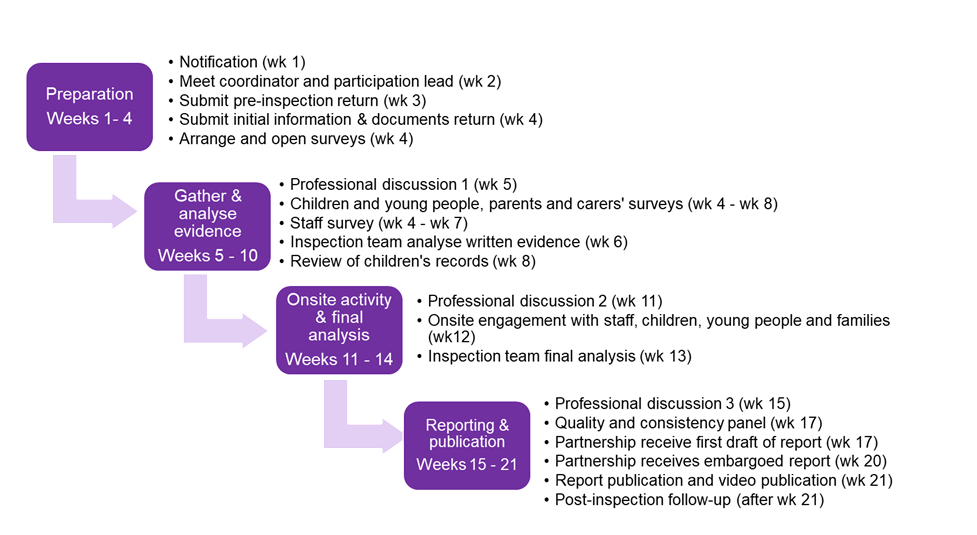Through a joint scrutiny approach, we will consider the experiences and views of children and young people. We will explore how well services are directed and delivered to ensure children are supported to live at home within their families to achieve positive outcomes.
Timeline
The principles of joint inspection
Our approach and framework
Reporting
Other helpful documents
Timeline
Preparation (weeks 1-4)
- Week 1 - notification
- Week 2 - meet coordinator and participation lead
- Week 3 - submission of pre-inspection return
- Week 4 - submission of document return
- Week 4 - arrange and open surveys
Gather and analyse evidence (weeks 5-10)
- Week 5 - professional discussion 1
- Weeks 4-8 - children and young people, and parents and carers' surveys
- Weeks 4-7 - staff survey
- Week 6 - inspection team analyse written evidence
- Week 8 - review of childrens records
Onsite acticity and final analysis (weeks 11-14)
- Week 11 - professional discussion 2
- Week 12 - onsite engagement with staff, children, young people and famileis
- Week 13 - inspection team final anaysis
Reporting and publication (weeks 15-21)
- Week 15 - professional discussion 3
- Week 17 - quality anad consistency panel
- Week 17 - partnership recieve first draft of report
- Week 20 - partnership receives embargoed report
- Week 21 - report publication and video publication
- After week 21 - post-inspection follow up
The principles of joint inspection
We will use a rights based approach in the joint inspections, embedding the experiences of children and young people at the heart of planning, implementation and analysis of findings. Our joint inspections are underpinned by the United Nations Convention on the Rights of the Child. For example we respect the right of children and young people to have their views heard by making participation of children, young people and families a core element of our approach. Our approach and design will reflect what children and families have told us matter the most to them, as encapsulated within the Promise.
We will consider the planning and progress that has been made by children’s services partnerships as they seek to keep The Promise. We will consider the five Promise Foundations and related priorities of family, care, voice, people and scaffolding which enable children to grow up loved, safe and respected.
Our approach and framework
Our approach will be proportionate to the evidence required, with a hybrid model of on-site and virtual activities. Our methods will include gathering information from local partnerships about the relevant services they provide and reviewing publicly available documents.
We will use the quality framework for children and young people in need of care and protection (November 2022). This framework is informed by the principles of the European Framework for Quality Management (EFQM) model which incorporates three tenets:
Direction – clarity of purpose and strategy to achieve aims
Execution – implementation of the strategy through delivery
Results – what results have been achieved
Reporting
We will publish one written report following each joint inspection. We are committed to improving accessible reporting specific to children and young people, this will involve further consultation with our young inspection volunteers.
In our report we will consider these three key lines of enquiry.
Children and young people are well supported to live with their families. This support helps to keep them safe, overcome difficulties and makes a positive difference in their lives.
The services children and young people receive are well planned and delivered in a way which is compassionate and by staff who put children and young people at the heart of decision-making. People in the workforce ensure that children, young people and parents are meaningfully listened to, heard and included.
Leaders and managers work well together to create and maintain a joined-up system of care which delivers the right services to each child at the right time. This provides children and young people, their parents and the workforce with help, support and accountability.
We will evaluate four quality indicators on our six-point scale. These are:
- Quality indicator 2.1: Impact on children and young people
- Quality indicator 5.3: Care planning, managing risk and effective intervention
- Quality indicator 5.4: Involving individual children, young people and families
- Quality indicator 9.2: Leadership of strategy and direction
Other helpful documents


